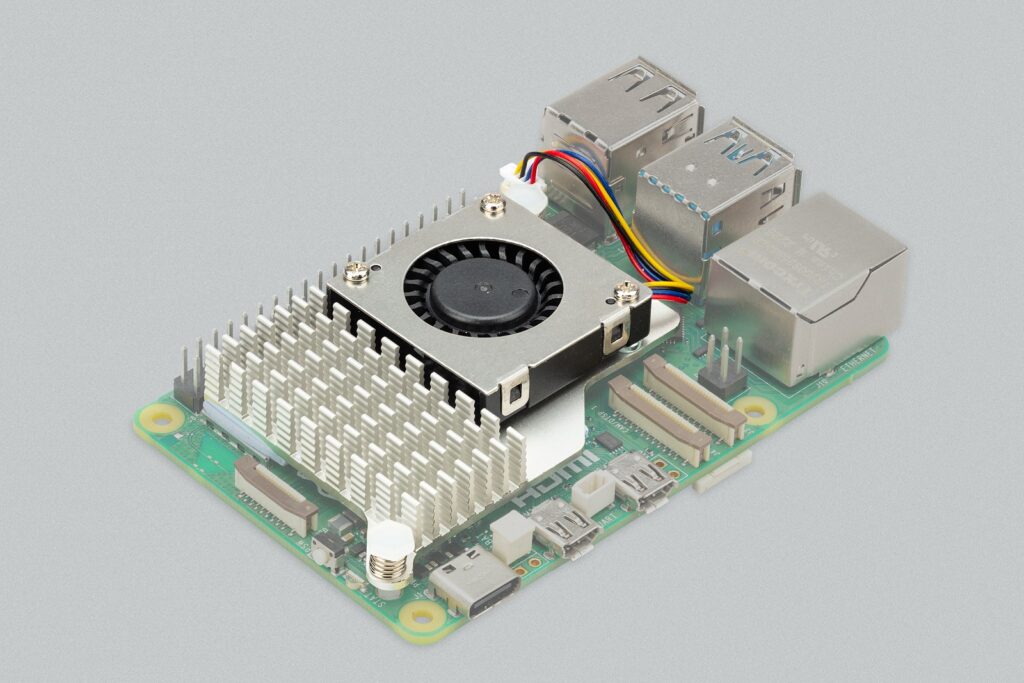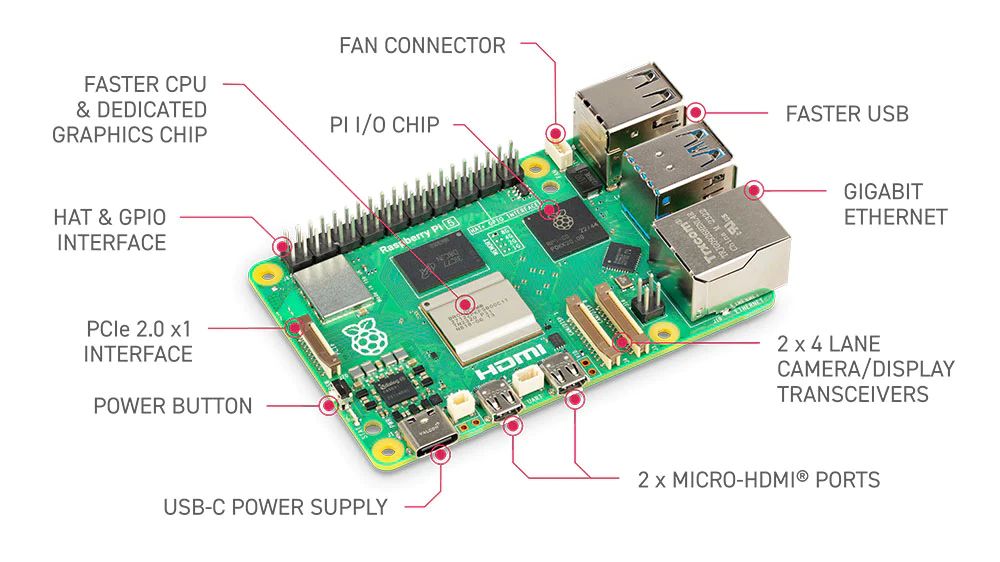The Raspberry Pi series has continually evolved, each iteration accompanied by notable enhancements whilst maintaining a competitive cost-performance ratio. The latest entrant, the Raspberry Pi 5, underscores this trajectory, manifesting a significant leap in processing speed and graphical capabilities compared to its predecessor, the Raspberry Pi 4.
The Raspberry Pi 4 has found a substantial user base, particularly within commercial, industrial, and educational domains, thanks to its competency in handling tasks such as streaming, PiHole Adblocking DNS operation, and home automation via software like Home Assistant.
Despite its merits, the Raspberry Pi 5 has faced some criticism from a consumer standpoint due to its higher price point when compared to other alternatives in the market, which are perceived as better value propositions.
Speculative Comparison: Raspberry Pi 5 and Raspberry Pi 4
The Raspberry Pi 5 transcends being merely a newer version; it epitomises a substantial progression in terms of capability and speed over the Raspberry Pi 4. This is demonstrated in an array of enhanced specifications:
| Raspberry Pi 4 | Feature | Raspberry Pi 5 |
|---|---|---|
| Broadcom BCM2711, Quad core Cortex-A72 (ARM v8) 64-bit SoC @ 1.8GHz | CPU | 2.4GHz quad-core, 64-bit Arm Cortex-A76 CPU, with 512KB L2 caches and a 2MB shared L3 cache |
| Integrated into CPU | Video | VideoCore VII GPU |
| LPDDR4-3200 SDRAM | RAM | LPDDR4X-4267 SDRAM |
| 2.4 GHz and 5.0 GHz 802.11ac Wi-Fi | WiFi | 2.4 GHz and 5.0 GHz 802.11ac Wi-Fi |
| Bluetooth 5.0 / Bluetooth Low Energy (BLE) | Bluetooth | Bluetooth 5.0 / Bluetooth Low Energy (BLE) |
| Micro SD card slot, with support for high-speed | Storage | Micro SD card slot, with support for high-speed SDR104 mode |
| 2 x USB 3.0 ports, supporting simultaneous 5Gbps operation. | USB 3.0 | 2 x USB 3.0 ports, supporting simultaneous 5Gbps operation (improved). |
| 2 x USB 2.0 ports | USB 2.0 | 2 x USB 2.0 ports (improved) |
| Gigabit Ethernet, with PoE+ support (requires PoE+ HAT) | Ethernet | Gigabit Ethernet, with PoE+ support (requires PoE+ HAT) |
| 2 x micro-HDMI® ports (up to 4kp60 supported) | HDMI | 2 x micro-HDMI® ports (up to 4kp60 supported) |
| 2 x 2 lane MIPI camera/display transceivers | DSI/CSI | 2 x 4 lane MIPI camera/display transceivers |
| Bus | PCle | PCIe 2.0 x1 interface for fast peripherals |
| 5V/3A DC power | Power | 5V/5A DC power for more peripherals |
| Raspberry Pi standard 40-pin header | GPIO | Raspberry Pi standard 40-pin header |
| Time over Internet connection. | RTC | Real-Time Clock (RTC), powered from external battery |
| N/A | On/Off | On-board power button!! |
Commonalities:
The Raspberry Pi 5 retains the compact form factor, 64-bit CPU architecture, dual-band Wi-Fi, Bluetooth connectivity, USB port configuration, and Gigabit Ethernet of its predecessor. Moreover, both models accommodate booting from Micro SD cards, underscoring a continuity in design ethos.
Differences Highlighted:
The Raspberry Pi 5’s processor, the Broadcom BCM2712, is notably more potent with its ARM-Cortex A76 cores clocked at 2.4GHz, compared to the BCM2711 of the Raspberry Pi 4. A notable transition is observed in the GPU department, where the VideoCore VII GPU of the Raspberry Pi 5 supersedes the VideoCore VI GPU of the Raspberry Pi 4, marking a significant enhancement in graphical processing capabilities.
The memory configuration also sees an uplift with the Raspberry Pi 5 employing the more advanced LPDDR4X-4267 SDRAM, available in 4GB and 8GB models initially, compared to the LPDDR4–3200 SDRAM of the Raspberry Pi 4 available in 1GB, 2GB, 4GB, or 8GB configurations.
Chipset Evolution:
The Broadcom BCM2712 SoC, succeeding the BCM2711 of the Raspberry Pi 4, catalyses the improved performance and capabilities manifest in the Raspberry Pi 5. The CPU, being a pivotal component, witnesses a significant upgrade which not only augments processing power but enhances the device’s operational efficacy.
The GPU upgrade in the Raspberry Pi 5 is also noteworthy, paving the way for an enhanced graphical processing capability suitable for graphically intensive tasks.
Memory, Connectivity, and Expandability:
The improved memory specification in the Raspberry Pi 5 notably amplifies device performance. While networking features remain consistent with the predecessor, the enhanced processing capabilities render the Raspberry Pi 5’s networking functions more potent.
The Raspberry Pi 5 also brings to the table significant enhancements in terms of expandability, featuring USB ports capable of simultaneous 5Gbps operation and a PCIe 2.0 x1 interface for rapid peripheral connections, a feature absent in the Raspberry Pi 4.
Video Transcoding and Decoding:
A distinctive advantage of the Raspberry Pi 5 is its ability to power two 4Kp60 HDMI displays concurrently, unlike the Raspberry Pi 4. This feature augments the Raspberry Pi 4’s dual 4Kp60 HDMI display output capability, catering to more demanding visual output requirements.
Real-Time Clock (RTC):
The integration of a Real-Time Clock (RTC) with an external battery connector in the Raspberry Pi 5, absent in the Raspberry Pi 4, is a boon for projects necessitating precise timekeeping.
Power Consumption and Cooling:

The Raspberry Pi 5 requires a 5V 4A power supply via USB-C, an increment from the 5V 3A power supply for the Raspberry Pi 4, harmonising with the more robust performance the Raspberry Pi 5 offers. An active cooler, designed for the Raspberry Pi 5, distinguishes it from the Raspberry Pi 4. The cooler, priced at $5, comprises a quiet radial blower channeling air through an aluminium heatsink, ensuring the Raspberry Pi 5 remains below its thermal throttle level even under demanding loads. This cooling solution is especially beneficial for those interested in overclocking.
Heat and Power Efficiency:
Without a cooling system, the Raspberry Pi 5 tends to run warmer compared to the Raspberry Pi 4, particularly during intense usage. However, with the Active Cooler, temperature regulation is effectively achieved, allowing for improved performance without overheating concerns. The official Active Cooler adeptly extracts heat from critical components, achieving an optimal balance between cooling and output, crucial for unleashing the Raspberry Pi 5’s full potential.
Performance Benchmarking:
Benchmarking elucidates the considerable advancements the Raspberry Pi 5 has made over the Raspberry Pi 4 in terms of performance. The upgraded Cortex-A76 CPU cores in the Pi 5 are anticipated to yield a 2-3x boost in CPU performance. Graphics performance on the Pi 5, courtesy of the upgraded VideoCore VII GPU, is estimated to be around 2x faster. Memory bandwidth sees a marked improvement due to the transition to LPDDR4X RAM, and storage performance benefits from the support for SDR104 mode on the microSD interface. Real-world testing revealed a swifter boot-up process and quicker webpage loading times on the Pi 5 compared to the Pi 4.
Cost Evaluation:
The enhanced features of the Raspberry Pi 5 come at a slightly elevated cost, with the 4GB model priced at $60 and the 8GB model at $80, compared to the Raspberry Pi 4’s 4GB model at $55 and 8GB model at $75. In the UK, the prices translate to £60 or £80 for the Raspberry Pi 5. Factoring in additional costs for active cooling, a protective case, and storage, the total cost approximates to £95, plus a further £20 for chosen storage. Some Home Assistant users advocate for SSDs due to their superior performance.
Criticisms and Alternate Options:
From a consumer’s vantage point, the higher cost of the Raspberry Pi 5 has drawn criticism, especially on platforms like Reddit. Critics argue that mini PCs or slim PCs offering superior performance can be acquired at a similar price point. For instance, the HP Slim S01-aF1015na, with an Intel Pentium Silver J5040 processor and a 128GB SSD, is available for just £110 on eBay with a 20% discount code. Alternatively, the NiPoGi Mini PC, sporting an Intel Celeron N5105 and priced at an economical £140 on Amazon, presents another viable option.
Concluding Insights:
In summation, the Raspberry Pi 5 embodies a significant advancement in performance, improved I/O options, and a slew of new features compared to the Raspberry Pi 4, albeit at a slightly higher price point. When factoring in additional costs for active cooling, a case, and an SSD, the total cost for a Raspberry Pi 5 setup aligns closely with that of a Mini PC. Consequently, for individuals seeking a cost-effective, low-powered server or streaming device, a Mini PC may emerge as a more pragmatic choice.

